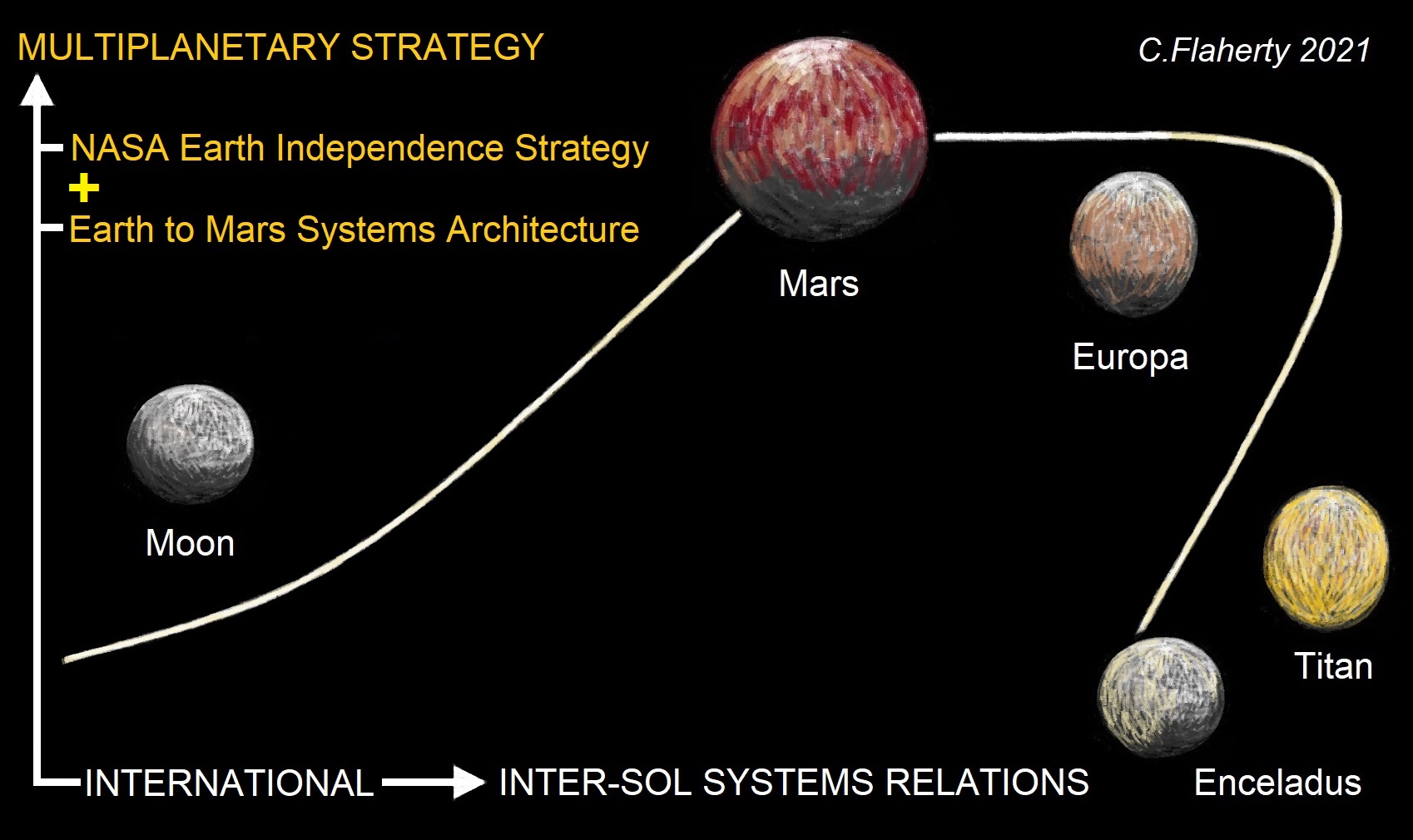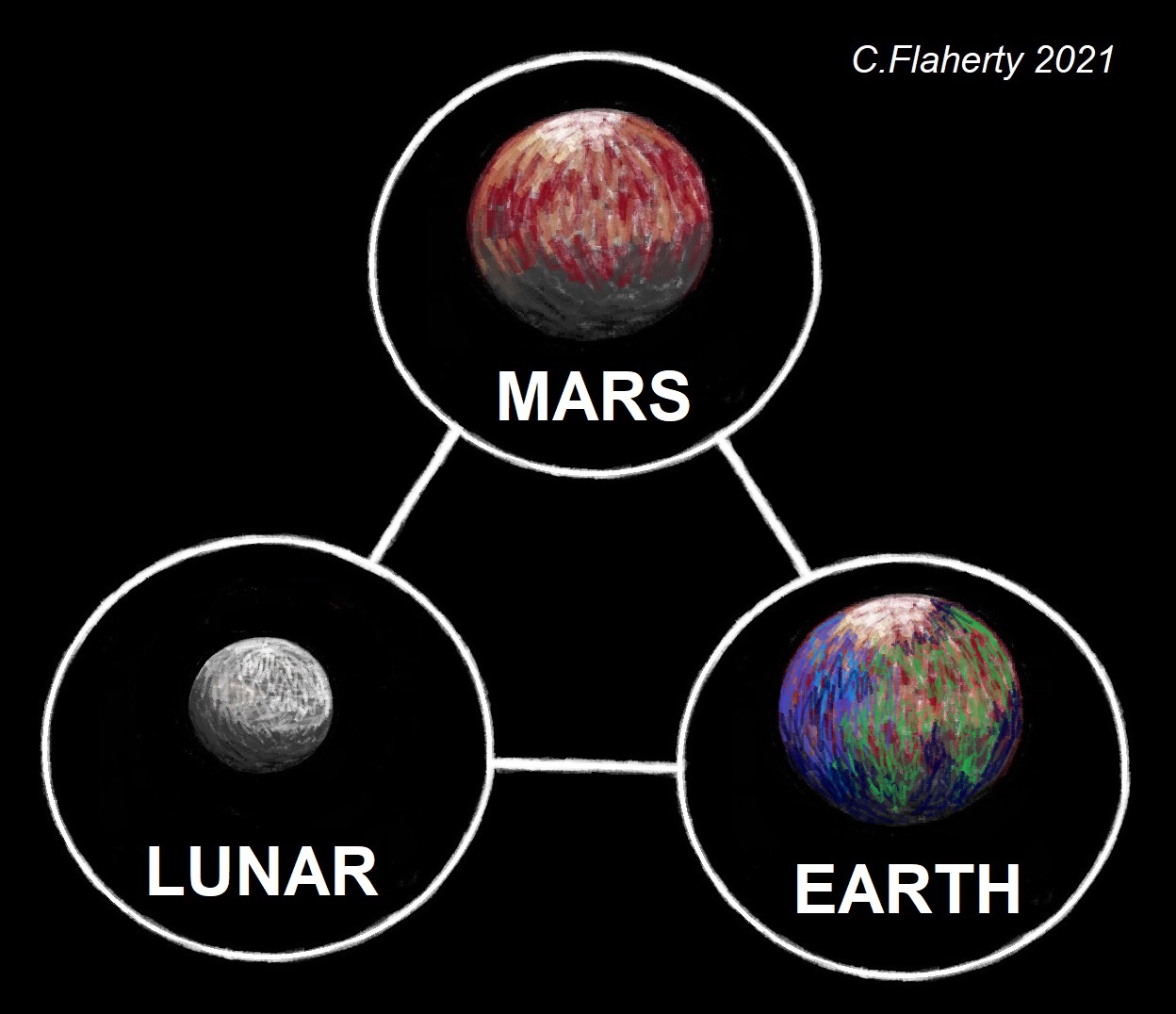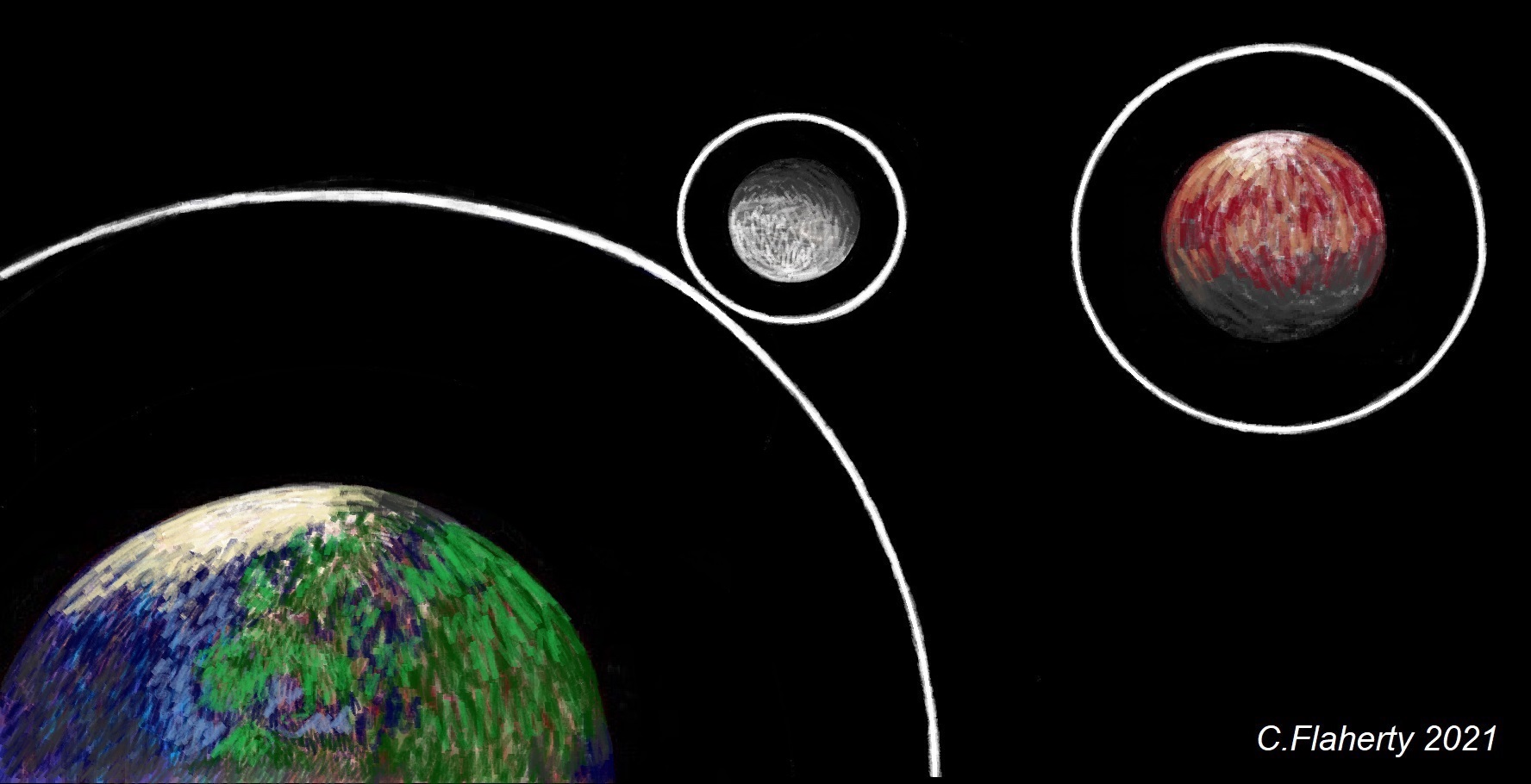
INTRODUCTION
This exploratory paper will look at the notion in Astropolitics theory, where massive technological change brought about by Space pioneering colonisation of the Earth’s Moon, and Mars, is suggested to effect world affairs bringing about a new form of interplanetary relations. The result of the notional merging of two exploration-pioneering technology strategies, namely: NASA Earth Independence Strategy (NASA, 2015); and, Earth to Mars Systems Architecture, leading to a seminal event – a massive Human surge into the Solar System – the year of a thousand starships, that sees the departure of the First Mars Colonial Fleet (Musk, 2017). The technology shift will lead to a Multiplanetary Strategy. This strategy is suggested will incorporate several worlds (nominal planets that are Human colonised) in the Solar System, the Earth, its Moon, Mars, and atmosphere worlds that may also show habitability for potential life: Europa (one of Jupiter’s Galilean Moons), Titan, and Enceladus (Saturn’s Moons). A radical shift in the form of a massive Human colonisation surge in the Solar System, can be seen as a point-in-time, where technology becomes a game-changer in relations between countries, to instead become relations between planets. The creation of a Triatic Interplanetary System, beginning when the Moon, and Mars colonisation achieve Earth Independence; will form three strategic regions of Space: Terra-Earth Space, Lunar Space, and Mars Space – all operating as their own Space-Control Domains.
ASTROPOLITICS THEORY

FIGURE 1: Illustrates the transition from Earth-Based International Relations to a new concept of Inter-Sol Systems Relations (along an X, and Y-axis). Merging of exploration-pioneering technology strategies: NASA Earth Independence Strategy, and Earth to Mars Systems Architecture, will create among several worlds a Multiplanetary Strategy, incorporating the Earth’s Moon, Mars, followed by target-worlds that have atmospheres and have habitability (where life possibly exists): Europa (one of Jupiter’s Galilean Moons), Titan, and Enceladus (Saturn’s Moons).
The focus of this exploratory paper, is to explore the possible radical shift towards Space-to-Space relations between various Human colonised worlds in our Solar System. Looked at in political terms, and looking at the notion that technology can be a game-changer in relations between countries, transitioning into relations between planets. A notional concept in Astropolitics theory,
“[identifies]… two distinct models of the future of the international system … one reflecting realist tenets and the other more liberal-republican in its inflection. The first … sees Astropolitik (a realpolitik version of Astropolitics) as the ability of great powers to dominate the Earth through the competitive mastery of Space. The second … argues that the expansion of global politics into orbital Space has the potential to foster a republican form of international government on Earth.” (Havercroft, 2009)
From the historical perspective, it is possible to identify transitional periods in political relations where massive shifts in technology created structural shifts in global affairs. For instance, the advent of new technology, during the late nineteenth and early twentieth century, particularly steamships, railways, and airplanes, has been argued to impact the course of world politics (Havercroft, 2009). A major shift occurring in Space exploration-pioneering technology, can similarly be argued to effect a new direction in global strategy from its Terrestrial-Based notion to a Space-Based view. This is likely to be the result of new exploration-pioneering technology underpinning a strategy moving from Earth reliance towards Earth Independence, and a notional Systems Architecture for creating a massed fleet of craft destined for colonisation of Mars (which will be discussed next).
FIGURE 1: Illustrates the emergence of interplanetary relations, or Multiplanetary Strategy along two notional axis. On the Y-axis, the merging of two exploration-pioneering technology strategies, namely the NASA Earth Independence Strategy, and the Earth to Mars Systems Architecture leading to the concept of Multiplanetary Strategy. This represents the notion that exploration-pioneering technology create opportunities that have a fundamental effect on global affairs, transforming relations between countries, into relations between planets. This is represented along the X-axis, where there is a progressive transition from Earth-Based International Relations to a new concept of Inter-Sol Systems Relations, that will likely emerge from the surge of Humanity into Deep-Space incorporating several worlds in the Solar System, namely the Earth, its Moon, first as a satellite, then as a fully-functioning colony with independence from Earth, and the next major colony of Mars. Beyond Mars, potentially using it as the next launch-point, future missions will reach-out to the target-worlds with atmospheres and potential for habitability (where life possibly exists), such as Europa (one of Jupiter’s Galilean Moons), Titan, and Enceladus (Saturn’s Moons). It is suggested, that as the Moons (of Earth, Jupiter and Saturn) become colonised by Humans, these for strategic-political purposes will be seen by the inhabitants as nominal planets in Inter-Sol System Relations.
TECHNOLOGY SHIFT
A major shift occurring in Space exploration-pioneering technology, can be argued to effect a new direction in global strategy. There are two models that could achieve this outcome. The first is the notion of becoming Earth Independent:
“Future pioneers of Mars will have to adapt to a more foreign, hostile environment. We will need new technologies to transform local resources into water, fuel, air, and building materials.” (NASA, 2015)
The type of technology requirements, for achieving Earth Independent capabilities include Mars surface landers, advanced and efficient in-situ resource utilization, surface mobility, permanent surface habitats, and crew transfer vehicles, such as the Mars ascent vehicle or a Mars vicinity crew taxi.
The second model for technology shift effecting global affairs, is a Systems Architecture strategy based on a rapid build-up of Mars destined craft,
“[timed to the next Mars and Earth rendezvous]… which is roughly every 26 months, that is when the … [Spaceships] … would depart. Over time, there … would be many … ultimately … [you would]… have upwards of 1,000 or more Spaceships waiting in orbit. Hence, the Mars Colonial Fleet would depart en masse.” (Musk, 2017)
The Systems Architecture needed for the massing of a Mars Colonial Fleet has two limbs, the first is the process of getting large numbers of craft into parking orbit. Craft are rocket boosted into orbit with dry tanks to await fuelling in Space. Craft are also launched with their payloads maximized, taking advantage of the fact that the weight of each craft was not taken up with the fuel needed for the journey to Mars. The schedule, and process of getting Mars destined craft into their parking orbit would be on a continuous repeat-mode: the rocket booster and Mars destined craft are launched into orbit; its rocket booster coming back quickly, within about 20 minutes to load another craft (Musk, 2017). Tanker craft launches are also envisaged under the Systems Architecture, these are used to fill up the Mars destined craft in their parking orbits. It should be noted, that in the last few years, the vision of the fuelling stage in parking orbit has changed with the prospect of using craft fitted with nuclear thermal propulsion, which is also expected to dramatically shorten transit-travel time from Mars to Earth (Delbert, 2020).
In the remainder of this exploratory paper, technology shift will be looked at in terms of the creation of a new form of political relations. Two aspects of this will be examined: creation of a Triatic Interplanetary System, and a new form of Multiplanetary Strategy.
The final sections of this exploratory paper will look at a wider future-scenario of how the First Mars Colonial Fleet could be organised, and how the build-up to its departure, is expected to have on Earth broader political, social, economic, and security implications. This set of discussions is followed by an overview of the real-world science, political and social issues underpinning the current search for microbial life and expectant eventual Human contact with Spacefaring Technical Civilizations, and how this would fit into an overall conception of Inter-Sol System Relations.
THE TRIATIC INTERPLANETARY SYSTEM
The concept of a Triatic Interplanetary System is in extension of four key strategic regions of Space:
| TERRA | The Earth, its atmosphere up until just below the lowest altitude capable of supporting unpowered orbit. |
| EARTH SPACE | Covers the region from the lowest possible orbit through to geo-stationary orbit. |
| LUNAR SPACE | Extends from geo-stationary orbit to the Moon’s orbit. |
| SOLAR SPACE | Consisting of everything in the Solar System beyond the orbit of the Moon. |
Sources: Dolman 2002; Havercroft, 2009.
As stated, the X-axis progressive transition from Earth-Based International Relations to a new concept of Inter-Sol Systems Relations (see FIGURE 1), that will likely emerge from the surge of Humanity into Deep-Space, will see a clear demarcation of three strategic regions of Space: Terra-Earth Space, Lunar Space, and a new strategic region of Mars Space – all operating as their own Space-Control Domains in a new Triatic Interplanetary System.
FIGURE 2: Illustrates the triatic relationships between the Earth, its Moon (Lunar), and Mars. It is anticipated that each of the worlds will operate as equal systems partners.

“FIGURE 2: Illustrates the Triatic Interplanetary System between the Earth, Mars and Lunar Controls.”
The two worlds: Lunar and Mars having achieved Earth Independence are expected to be able to operate as separate governmental entities in terms of day-to-day administration, security, management of science, and economic activities. This includes coordination, communication and movement of industrial products, people, cargo, and supplies.
Successful colonial operations on the Earth’s Moon, and Mars, will achieve Earth Independence. The relationship between the three worlds: the Earth’s Moon, and Mars, will give rise to a new type of Multiplanetary Strategy discussed next.
MULTIPLANETARY STRATEGY
The 1967 Outer Space Treaty in general forbids in relation to Space, the Earth’s Moon, or any other world, “national appropriation by claim of sovereignty, by means of use or occupation, or by any other means” (United Nations). The extent of this provision, is that even though occupation of a place is tacitly recognised, as a practical necessity such as the landing of a craft on the surface of a world; attached to this action, is a right not to be interfered with by the actions of another state, while an activity is in progress. However, such occupation, even if foreseeably long-term,
“[on]… the Moon and other celestial bodies, gives rise to no sovereign rights over those areas.” (Cheney, 2020)
As long as the purposes are peaceful, the Earth’s Moon, or Mars, is free for exploration and use by all states (United Nations). However, it should be noted that exploitation (rather than exploration) may be curtailed by the notion of Planetary Protection (discussed later in this paper). The right to occupation status would initially extend to use of the Moon, and Mars with Human colonisation presumably under national, or multi-national Space agency management, or under contractual agreement with a national government. This is currently provided for under the conversion from the original terms of the 1967 Outer Space Treaty into,
“modern International Space Law as it makes states responsible for the activities of their nationals and private corporations in outer space and requires that they ‘authorize’ and ‘continually supervise’ those activities. Similarly, Article VIII establishes that the state on whose registry a Space object is carried ‘retains jurisdiction and control’ over the space object and its personnel.” (Cheney, 2020; United Nations)
The notion of Space agency management has been posited in Astropolitics theory, where a policy regime has been suggested implementing the free-market exploitation (rather than pure exploration) of Space, planets, moons and asteroids,
“[and]… the final step would be the establishment of a national space coordination agency to define, separate and coordinate the efforts of commercial, civilian and military space projects” (Dolman, 2002; Havercroft, 2009).
The model for how the colonisation of the Moon would be effected, is likely to be similar to multinational collaboration currently seen with the International Space Station (ISS). However, the question arises at what point will we see some form of interplanetary relations emerge, where Moon-based activities have reached a scale of effort, where administration from an Earth-Based agency is no longer feasible. A point could be reached on the Moon where business and trade activities set-up by private companies and individuals offering services to Space Programs, and mining the Moon – all of which operate Earth Independent. At this point, a type of dependency relationship exists between the two worlds. One – the Moon, is now providing products for Earth as well as local consumption and use, such as the harvesting-manufacture of water, oxygen, Helium-3, and producing rocket fuel – all of which could grow politically and economically into powerful mining and industrial concerns on the Moon. At that point, decoupling of the Moon from Earth at an organisational and business level, may see a progressive broader decoupling of personal, and individual interests from actual national-institutional linkages especially if these were weak, or tenuous to start with; or simply too politically incompetent to hold onto control. The pattern of decoupling would likely follow an almost identical process to how far-flung colonies in Earth’s history started to show independence from their parent countries. This reflects a notion in Astropolitics theory, that the neutrality of Space presents a fundamental threat to a countries’ security, as treating Space as, “a neutral sanctuary could be interpreted as a sign of weakness that potential rivals might exploit.” (Havercroft, 2009)
In many cases, the opportunity to ‘move-off world’ and join like-minded becomes for many the opportunity to escape political, social, and economic repression at home, and open new opportunities in a wider international (Inter-Space) community. This phenomenon would become a reversal of the original contention in one branch of Astropolitics theory, that the effect of international cooperation in Space, and expansion of global politics into orbital Space has the potential to foster a republican form of international government on Earth (Deudney, 2007; Havercroft, 2009); this might actually reorient in Space, into a fostering of republican form of international government by the Humans on the colonies of the Moon, and Mars. It might well be, that there is tacit acceptance of this, a result of relatively weak governments on Earth having to accept that the spear-head of colonisation will end up in the hands of private citizenry, transnational corporations, and international organisations who have the economic and political might, wherewithal, and global coordination to achieve the impossible.
A further development may be the conversion of the original formulation of the terms of the 1967 Outer Space Treaty from its current focus on countries, to individuals in Space. As a political concept, how is the expanse of Space to be regarded? Currently it is covered by United Nations’ protocols, however that is largely from an Earth centric perspective; the notion fundamentally shifts once Humans have achieve Earth Independence and are living, trading and working on various planets, moons, Deep-Space Stations and the Main Asteroid Belt (that orbits the Sun between Mars and Jupiter). At what point do we give credence to the notion of dual citizenship. Alternatively, if we accept the basic precept that ‘Space is for all of Humanity’, which usually paraphrases the 1967 Outer Space Treaty,
“the exploration and use of Outer Space shall be carried out for the benefit and in the interests of all countries and shall be the province of all mankind” (United Nations).
It is possible that a mass surge of Humanity into Deep-Space, and colonisation on several worlds could shift the emphasis from any nationalistic connections to an expanded notion that people are Sol-System citizenry, and that the Solar System is a Human domain. Further, do we need to accept the notion that long-term habitation, and perhaps with the first birth of a Human on the Moon, or Mars (if this is biologically possible), may create a legal notion of a Lunar, or Mars citizen, and do the people living and working on those worlds identify with those places, rather than historical citizenship of one of the Earth nations.
A shift from an Earth-Based to a Moon-Based agency to organise science, exploration, and economic activities on the Moon, and ultimately rocket launches from the Moon’s surface, for Deep-Space missions, would set the eventual pattern for further colonisation of Mars. A Triatic Interplanetary System that sees the interoperation between the Red (Mars), Grey (Lunar), and Blue and Green (Earth), worlds operating a mutually dependent system exchanging communications, trade, people and transportation links. The three worlds are anticipated to operate in equal relations. This will begin, it is expected a new form of Multiplanetary Strategy.

“FIGURE 3: Illustrates three strategic Space regions of: Terra, and Earth Space; Lunar Space; and Mars Space.”
FIGURE 3: Looks at the three strategic regions: Terra-Earth Space, Lunar Space, and Mars Space. The set-up of a Triatic Interplanetary System: a dependency relationship between Mars, Lunar, and Earth Controls, will be based on the Earth’s Moon, and Mars achieving Earth Independence. This will introduce the first major step towards interplanetary relations between the Earth, Moon and Mars. The set-up of Moon, and Mars satellite systems for planetary Global Positioning, along with coordination and communications systems, and interplanetary linkup between three respective planetary control centres, will establish a new set of systems relationships. This will involve continuously operating exchanging communications, trade, people and transportation linkages, between Mars, Lunar, and Earth Controls. This will introduce the first major step passing from a conventional Astropolitical notion of a Terrestrial-Based national interest in Space, converting into the notion of interplanetary relations between the Earth, the Moon and Mars – all with their own interests.
FUTURE-SCENARIO OF HOW THE FIRST MARS COLONIAL FLEET COULD BE ORGANISED FOR EARTH DEPARTURE
This section will look at a hypothetical future-scenario about how the departure of the First Mars Colonial Fleet could be organised. This will serve as a back-ground discussion to end-essays looking at the broader political, social, economic, and security implications of the build-up to the departure of the First Mars Colonial Fleet.
It can be suggested that once Mars destine craft are assembled, the final stage would be crew and passenger transit to each craft in sequence, using the same process used getting the craft into their parking orbits. Docking capsules launched by booster rockets, then return to Earth, or from a near-by Space Station Docks for the next crew. Successive loading crews and passengers, would lead, rather than a massed fleet moving towards Mars, a continuous line of craft in transit – in staggered succession, rather in the fashion of a wagon train. While operating independently, it is conceivable all ships in the train will be in continuous communications. Where miss-haps, technical problems arise, and even ship failures occur others in the train will be in a position to move-up rendering assistance. It is conceivable that some of the ships in the fleet might be designed with specialist functions such as reserve carriers, remotely slaved to other ships to be used as rescue and reserve ships. Still others might conceivably be fitted specifically as medical and rescue, repair and factory craft. Drone-ships used as fuel barges, and fuel factory ships with the capacity to collect fuel requirements along the transit to Mars could see use. The specialised craft might be used as the first Mars settlement building blocks.
It can also be suggested that the first steps in the build-up to the departure date of the First Mars Colonial Fleet, will be the mass launching of hundreds of robotic rovers, following the current missions:
“already at Mars, operating … highly effective robotic emissaries in orbit and on the surface … [mapping]… detailed mineral composition in select areas and … [locating]… suitable landing sites for future robotic and human missions, many with incredible science potential.” (NASA, 2015)
The initial wave of First Mars Colonial Fleet support rovers will land at various positions on the surface of Mars and start mapping, searching for suitable landing positions. The rovers will monitor weather and climate conditions, identifying water, and mineral resources that can be exploited to get the colony up and going. As stated previously, the set-up of a Mars’ satellite system for planetary Global Positioning, along with coordination and communications systems, and interplanetary linkup of a Triatic Interplanetary System relationship between Mars, Lunar, and Earth Controls, will introduce the first major step passed the conventional Astropolitical notion of a Terrestrial-Based national interest in Space, converting into the notion of a interplanetary relations between the Earth, the Moon and Mars. This will also lead to significant conceptual shift in terms of Humanity marking out its home Solar System as a political entity: the Sol-System, with its own interplanetary relations, and inter-open Space relations, covering the Space expanse to the perceived limits of the Solar System.
In the final section of this exploratory paper a future-scenario will look at some of the Earth-Based political, social, economic, and security implications of the build-up to the departure of the First Mars Colonial Fleet.
BUILD-UP TO DEPARTURE OF THE FIRST MARS COLONIAL FLEET
This section will look at a future-scenario of the build-up to the departure of the First Mars Colonial Fleet. It will look at three sets of wider effects on Earth, in terms of: (1) Economic; (2) Security; and, (3) Political and Social implications.
(1) Economic Implications
The build-up to the year of a thousand starships, the anticipated departure of the First Mars Colonial Fleet will be unlike any of the previous first fleets, as this will rapidly become a global exercise, taking several years to concentrate, as a global community look-up into the night and day skies seeing Space-docking facilities, and a massively expanded Space Station. Massive economic, political, military, civil and scientific resources will be drawn-in globally. The most visible signs will be the construction and conversion of oil rigs into Space Launch Ports, moved far out to sea to allow safe multiple launches of the Super-Heavy Lift Rockets. The ultimate economics of the build-up to departure of the First Mars Colonial Fleet, are impossible to estimate. However, the current economic impact of the Global Space Industry has so far shown exponential sector growth. In 2019, the Global Space Economy grew to $423.8 billion USD, up from an estimated $345 billion USD in 2016 (Space Foundation, 2020). The Global Space Economy in near-term forecast-estimates is predicted,
“as an investment theme … likely to impact a number of industries beyond Aerospace and Defence, such as IT Hardware and Telecom sectors … [and]… could generate revenue of more than $1 trillion or more in 2040” (Morgan Stanley Research).
It is predicted that the build-up to the departure date of the First Mars Colonial Fleet, could grow to become planetary-level focus of economic and business activities. The global effort would likely engage millions of employees, in multiple countries, with budgets running into the trillions. At that scale it could largely begin to reconfigure the global economy much like the fight against Covid-19, or the anticipated fight against climate change.
(2) Security Implications
Globally, the build-up to the departure date of the First Mars Colonial Fleet, will likely represent the greatest single long-duration security operation in history, and will need multi-national input. Consider, the need to set-up quarantine reception, housing, medical, and psychological facilities needed to process thousands of ground, and flight staff, and the astronauts, as we can anticipate that there will continue to be a global pandemic threat. The build-up will likely see a high degree of military coordination, seeing entities like the U.S. Space Force playing a role in Low Earth Orbit, and Cislunar Security, essentially acting as Space Coast Guard, aiding Humanitarian, Spacecraft, and Space Infrastructure failures and miss-haps. There will be an obvious need for law enforcement, and this might see the recruitment of police to operate alongside the force of Space Coast Guardsmen. One of the greater threats that will likely impact the security thinking going forward, during the build-up to the departure date will be the problem of conspiratorial and fantasy driven and inspired violence, extremism, and terrorism that may pose multiple threats to safety and security of the people involved in the First Mars Colonial Fleet, its infrastructure and craft being assembled. This overly complex new form of violence, extremism, and terrorism has largely made its appearance in 2020, with the pandemic crisis however, it is largely expected to continue building on a long cultural history of alien abductions, technology secrecy and government conspiratorial fantasy beliefs among many in society.
(3) Political and Social Implications
The build-up to the departure date of the First Mars Colonial Fleet, will have its own political and social momentum, as the whole exercise moves from science-fiction thinking, to science-fact, concept development, to real-world fact, to ‘this is happening’. Under United Nations mandate a flurry of diplomatic activity, treaties, Space laws and governance will have to be negotiated between the premier Space-Faring countries. It is anticipated this could largely follow the Astropolitics theory model, namely:
“application of the prominent and refined realist vision of state competition into Outer Space policy, particularly the development and evolution of a legal and political regime for Humanity’s entry into the cosmos” (Dolman, 2002; Havercroft, 2009).
Immigration rules, allowing rapid movement of people will be required and recruitment will start to gain pace – drawing the ‘best and brightest’. This may well lead to national competition as governments try to get a place for their best representative citizens to be part of the ‘great enterprise’, hoping to ensure a future stake in Deep-Space, Mars, and the beyond. News and Social Media will be dominated by the build-up. The hype-train will likely see mock starships, and interpretive-educational spaces in the major world capitals. Thousands visiting and buying merchandise in much the same way that Apollo 11 commemorative memorabilia was sold at the time of the original landing in many department stores.
FINDING MICROBIAL LIFE AND EXPECTED EVENTUAL CONTACT WITH SPACEFARING TECHNICAL CIVILIZATIONS
The final section of this exploratory paper will overview the real-world science, political and social issues underpinning the current search for microbial life and expected eventual Human contact with Spacefaring Technical Civilizations that have underpinned much of the Space Program since its inception. This is largely thought to be either:
“finding microbial life in our Solar System or intercepting a microwave transmission from many light years away” (Harrison, 2011).
Well-known pursuits have been NASA’s SETI Program, that became the SETI Institute; and the United Nations Office for Outer Space Affairs (UNOOSA), that has in the last decade,
“announced … it will consider drafting protocols for what to do when we finally make contact with extra-terrestrial civilizations in Space.” (Kaku, 2010)
The most well-known example of this acceptance-expectation of eventual contact is the golden record: a gold-coated copper phonograph record affixed to each Voyager craft,
“as a message to possible extra-terrestrial civilizations that might encounter the Spacecraft in some distant Space and time.” (Sagan, 1978)
The most challenging notion, is that the departure of the First Mars Colonial Fleet as a global exercise will signal a massive Human surge into the Solar System, marking this as Human territory and while the common misnomer has been to see this akin to Earth’s colonial past – it will not be, it needs to be looked at (and understood as), a biological process of an invasive species, moving-into and taking-over an alien environment. The major shift in NASA robotic missions, in the 2020s is to, “seek signs of life” (NASA, 2015). Finding microbial life in our Solar System will raise a central ethical question, even if the life discovered is microbial, what rights of protection do we as Humans give this? The fundamental problem is the,
“[thinking and treatment of]… Space as a resource to be mastered and exploited by Humans, a Terra Nulius, or empty territory, to be colonised and reinterpreted for the interests of the coloniser.” (Havercroft, 2009)
For instance, the Committee of Space Research’s Planetary Protection Policy (PPP) seeks protection of the Space Environment from, “harmful contamination”, which in the main is trying to avoid endangering the integrity of the scientific exploration of Outer Space including the search for life (COSPAR, 2020; Cheney, 2020) In essence, a type of normative rights for protection of alien life (upon its contact with Human explorers), exists under the concept of,
“Planetary Protection … [that]… is critical for enabling scientists to study the natural environments of celestial bodies without interfering with possible life forms that may have developed there.” (Cheney, 2020)
This reflects the notion, of a need for a broader environmental perspective namely the concept of a necessity to protect the Outer Space as an environment in its own right (Cheney, 2020). The preservation of another planet, or world’s ecosystem from Human contamination will be crucial in terms of answering the fundamental science, of how does life begin? However, the problem posed by potential shift from a purely exploration mode of operations to economic exploitation raises the troubling problem of Earth’s colonial history, that has been bloody, exploitative and created destructive racial and sectarian divides, that we live with currently on Earth.
Historically speaking, colonialism has devastated, destroyed, and caused massive extinction-level events in Earth’s planetary environment. Establishing Human dominance over the Solar System, will by its very nature be about the invasive establishment of Humans in pristine worlds, seeking economic exploitation (rather than pure exploration), in order to sustain the new Space-Based economy. The very premise of the notional departure of the First Mars Colonial Fleet is that it will occur as a massive surge event. It could end up being like the old European empires ‘scramble for the colonies’, or the drive West in U.S. history, which was chaotic, bloody, and full of confrontation between Native American civilisations, pioneers, colonists, adventurers, local peoples and communities. Added to the potentially explosive mix, could be the first verified contact with the nearest Spacefaring Technical Civilization to Earth.
Human Contact With a Spacefaring Technical Civilization
The notion of Human contact with a Spacefaring Technical Civilization stripped of its conspiratorial, fantasy and science-fiction attributes, has been, and continues to be part of the Space Program, and has been an historical eventual expectation on the part of Space Science. The proposition made in the past in regards to a possible nearest Spacefaring Technical Civilization to Earth is that one of these may in fact,
“[be]… here, but in hiding because of some … ethic of non-interference with emerging civilizations.” (Sagan, 1980)
One argument is that such a species might use technology, have an appearance, and may be completely unintelligible to Human perception. One of the early theories of the Space Program was that Humanity would send a signal into Outer Space, soliciting a response, that would then lead to the following scenario:
“The receipt and return of such a signal would announce our presence as a Technical Civilization, and … would be followed by a special contact mission. Even if an intelligible interstellar signal were received and returned today, it would be several hundreds of years before the contact mission could arrive on Earth.” (Sagan, 1963)

“Voyager Golden Record”
It could be argued that the massive Human surge into Space, with the departure of the First Mars Colonial Fleet as a global exercise by Earth could call the interest of one of the Technical Civilizations. Contact with intelligent life would form part of an ever-evolving concept of Multiplanetary Strategy. However, given the immense distances that likely exist between Spacefaring Technical Civilizations, it was anticipated that like Earth, they will likely have had their own Deep-Space missions, that have been ongoing for hundreds, if not thousands of years (Sagan, 1963). In a somewhat similar way, Voyager1, is now some 43 years (launched in 1977) into its mission.
Voyager1 has now crossed the Heliosphere, the boundary where the influences outside our Solar System are stronger than those from our Sun, and is the first Human-made object to venture into Interstellar Space (NASA, 2019). It has been argued-theorised, the immense distances between Spacefaring Technical Civilizations, likely means these operate as distance trade-partners, exchanging ideas, knowledge, artifacts and biological specimens (Sagan, 1963). The golden record currently conveyed on Voyager1 could become Earth’s first trade-offering. The reciprocal exchange of an ‘alien golden record’ – when and if that comes may be hundreds of years later. However, its arrival may become a fundamental Inter-Sol Systems Relations question: how this will be shared, or will it be monopolised leading to conflict, or war between Humans.
The prospect of Space-to-Space War will remain an ever present reality. The mass generation of Human activity in Space, will automatically give rise to political, rights issues, and by extension defence and security issues. This will likely give rise to an expanded role for a Space Force for law enforcement, and protection. This will also greatly expand the notion of the capability to fight a Space-to-Space War, or a Space-to-Another Planet War. Even though the underpinning United Nations’ principle is the non-military use of Space, contained in the 1967 Outer Space Treaty (United Nations), the realities are currently the capabilities needed to fight in Space are growing exponentially. The other conceptual problem is that conflict on Earth between countries will continue, and how this translates into conflict on the Earth’s Moon, or Mars between respective citizens will remain problematic. In past wars, situations have been known where far-flung colonies have stayed-out, remained neutral or operated under privately agreed detente under the mantel of various United Nations’ Humanitarian Protocols.
REFERENCES
- Committee of Space Research (COSPAR). 2020 Policy on Planetary Protection. COSPAR Panel on Planetary Protection. Approved by the COSPAR Bureau (17 June).
- Cheney, T. Newman, C. Olsson-Francis, K. Steele, S. Pearson, V. Lee, S. 2020 Planetary Protection in the New Space Era: Science and Governance. Frontiers in Astronomy and Space Sciences (13 November).
- Delbert, C. 2020 Tiny Nuclear Reactors Could Help Us Get to Mars: But Who Will Build Them? Popular Mechanics (7 April).
- Deudney, D.H. 2007 Bounding Power: Republican Security Theory from the Polis to the Global Village. Princeton University Press.
- Dolman, E.C. 2002 Astropolitik: Classical Geopolitics in the Space Age. Frank Cass.
- Harrison, A.A. 2011 Fear, Pandemonium, Equanimity and Delight: Human Responses to Extra-Terrestrial Life. Philosophical Transactions of The Royal Society. Volume 369. Issue 1936 (3 February).
- Havercroft, J. Duvall, R. 2009 The Geopolitics of Space Control and the Transformation of State Sovereignty. Bormann, N. Sheehan, M. (Editors) Securing Outer Space: International Relations Theory and the Politics of Space. Routledge Critical Security Studies.
- Kaku, M. 2010 U.N. to Establish Protocols for When We Make Contact With Aliens. Big Think Website (27 September).
- Morgan Stanley Research. 2020 Space: Investing in the Final Frontier. Morgan Stanley Website (24 July).
- Musk, E. 2017 Making Humans a Multi-Planetary Species. New Space. Volume 5. Number 2.
- NASA [National Aeronautics and Space Administration]. 2019 Voyager 1. NASA Science Solar Systems Exploration Webpage.
- NASA [National Aeronautics and Space Administration]. 2015 [-2016] NASA’s Journey to Mars: Pioneering Next Steps in Space Exploration. Government Printing Office (October 2015; February, 2016).
- Sagan, C. 1980 Cosmos. Penguin Random House.
- Sagan, C. 1978 Murmurs of Earth: The Voyager Interstellar Record. New York: Random House.
- Sagan, C. 1963 Direct Contact Among Galactic Civilizations by Relativistic Interstellar Spaceflight. Planetary and Space Science. Volume 11. Issue 5 (May).
- Space Foundation [Editorial Team]. 2020 The Space Report. Space Foundation Website.
- United Nations Office for Outer Space Affairs (UNOOSA). Resolution Adopted by The General Assembly 2222 (XXI). Treaty on Principles Governing the Activities of States in the Exploration and Use of Outer Space, Including the Moon and Other Celestial Bodies.
Chris Flaherty authored the Terrorism Research Center’s report – Dangerous Minds (2012). He was the co-primary author, along with Robert J. Bunker of the book – Body Cavity Bombers: The New Martyrs (iUniverse, 2013). Two essays of his, from 2003 and 2010 were reprinted in the Terrorism Research Center’s book – Fifth Dimensional Operations (iUniverse, 2014). He recently contributed a book chapter – The Role of CCTV in Terrorist TTPs, edited by Dave Dilegge, Robert J. Bunker, John P. Sullivan, and Alma Keshavarz, the book – Blood and Concrete: 21st Century Conflict in Urban Centers and Megacities, a Small Wars Journal anthology, published on behalf of the Small Wars Foundation with Xlibris (2019).
Dr Chris Flaherty https://au.linkedin.com/in/drchrisflaherty





